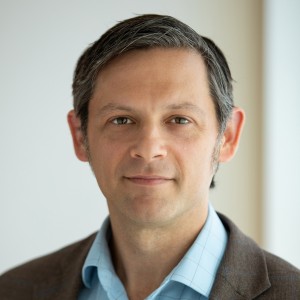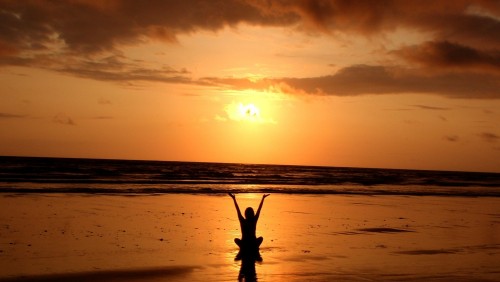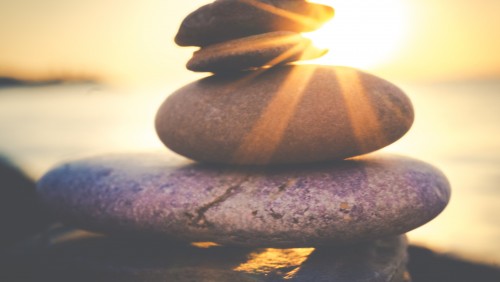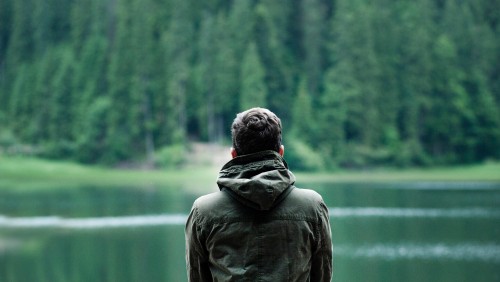Mindfulness, or learning to view thoughts and feelings as observable phenomena instead of “the truth” or “threats,” has been instrumental in my journey through OCD. But it was only in the last five years or so that I really started meditating. This was spurred in part by the fact that the $200 I cleverly spent on the lifetime membership to the new Headspace app ended up being 200 euros. Oops. But since it felt like something I really had to get my money’s worth from, I used it often.
The link between meditation and being a generally more mindful person revealed itself gradually over the years, just enough to keep me interested. Just as articulating my experience of CBT in online support groups led me to become a CBT therapist, articulating my understanding of mindfulness to my clients with OCD helped me as much as them. But it recently occurred to me that I was essentially bragging about knowing something amazing I had only just scratched the surface of. Dan Harris, in his charming book 10% Happier, would eventually plant the seed in my head that there was this thing called an intensive meditation retreat, where “serious” meditators went to train their minds. If that skeptic could do it, then so could I.
And so I found myself at the Insight Meditation Society (IMS) in Barre, MA (pronounced like the Manilow, not like the pub), attending the Discovering Freedom Labor Day Meditation Weekend led by Anushka Fernandopulle and Pascal Auclair. It struck me, in the few weeks leading up to the event, that I was way in over my head. Three days with no phone, no social media, no television, no talking, no music, no reading, no writing, no working, no meat, no family members or friends, and no real sense that I know what I’m doing. Two weeks before the retreat, I started training for the 3-day event like a marathon, increasing my usual 10-20 minute meditation practice to 30-45 minutes a day.
Armed with the knowledge that I could do at least that, I carefully followed the IMS’s detailed instructions of what to bring, with one notable exception – a wristwatch. I don’t own one for the same reason I don’t carry a calculator around. I have a smartphone. As I arrived at BWI airport, I started to obsess that, without my phone, the lack of time awareness could make me go insane. The only options at the duty-free store were a bright pink jewel-bedazzled $30 watch made for an adolescent girl or a $250 one clearly made for an alpha male investment banker. I balked, figuring I could try again at the airport in Boston. There again I had no luck, finding only a $400 Apple watch that would surely be against the retreat rules. So I would go into the wilderness, with no sense of time.
Game of Thrones
When I arrived, I was greeted by friendly volunteers who checked my name off the list and invited me to claim my spot in the meditation hall. Off to the left, the foyer gives way to a large open space with mats filling the center, chairs along the sides and back, and an altar to Buddha in the front. Business in the front, party in the back, or the feng shui equivalent of a mullet. My knees do not allow for long periods of floor-sitting, so I always meditate in a chair. From a large collection of pillows, blankets, cushions, zafus and so forth, I chose a lumbar supporting cushion and claimed my chair.
I’m used to just using a pillow to support my lower back in my office chair, so I was very impressed with myself finding a lumbar supporting cushion that would give me perfect posture during the retreat. But after a few sittings, my back starting to throb terribly. I moved the cushion up and down several times, put an extra cushion in front of it, then a rolled up blanket under it, then another rolled up blanket on top of that, finding myself nearly pushed off the chair with four different “supporting” strategies behind me in the end. On the last day, I just used the chair as a chair. No pain. Simplicity wins again.
After claiming my meditation throne, I was instructed to go finish the registration process. This began with filling out a few health waivers and confessing my history of mental illness, giving them permission to politely ask me to leave if I completely lose it. Next I was asked to sign up for my yogi (meaning meditator) job. To keep the staff needs low and to add some variety to the meditative practice, retreatants are asked to spend about an hour a day maintaining the place. I leapt at the opportunity to do the dinner dishes because I’m terrible at other forms of cleaning and I (correctly) suspected this would be an adventure. Later that evening, myself and another retreatant were trained in operating the industrial dishwasher, wherein my job was to place a tray full of dirty dishes inside, pull the lever, let the machine scare the germs away in 90 seconds or less, and then my partner would put the clean dishes back where they belong. So each dinner shift, I would finish eating early on, meet my partner in the back, and challenge myself to clean the dishes as quickly as they came back. Maybe it wasn’t my most mindful approach, competitive dishwashing, but I felt completely connected to what I was doing, and I have never felt more proud of pretending to have a job.
After registration, we were given a brief tour of the compound, the different dormitories, offices, meditation rooms, restrooms and so on. This must be an interesting place for someone with contamination OCD. Every bathroom is equipped with signs extolling the virtues of handwashing and the role it plays in responsibly avoiding the harming others with your nasty germs. Hand sanitizer can be found nearly every ten feet. Notably, this emphasis on hand washing comes with no sense of irony that we are all spending the majority of our time walking around barefoot, and sharing meditation mats and blankets with abandon.
Try Not to Murder Anyone for a Whole 3-Day Weekend
The first evening, all 100 of us met in the meditation hall and listened to our teachers explain some of the Buddhist precepts (or guidelines) we were going to adopt for the next few days.
- No harming or killing anyone, ok? Or anything, if you can avoid it. Even insects. The window sills boasted cups with the words “insect relocation device” written on them to encourage you to gently release bugs back into the wild.
- No stealing. More specifically, no taking anything that isn’t freely given, including people’s attention.
- No sexual misconduct. Keep your hands to yourselves. Actually, keep your hands off yourselves too while you’re at it.
- No using of words to harm others, such as lying or gossip. This one should be easy because, no talking.
- No getting intoxicated. This is considered a moral precept because of the carelessness it could lead to in the other precepts. But really, being intoxicated in this environment would be awful anyway and really defeat the purpose.
I think any reasonable person could get behind these moral guidelines, from any religious or cultural background.
We also learned about the “noble silence” we were about to adopt. There would be no talking, no using of phones, no reading or writing, and notably, no other attempts to communicate with one another. Sustained eye contact or big “wassaaaap” and “how you doin’?” facial expressions are, um, frowned upon. The reasoning for this is interesting. It’s not, as I had assumed, just about keeping your own mind settled. It’s actually a gift to the other retreatants to whom your attempts to get attention may be a distraction from their own process. In other words, trying to interact with someone means placing on them the burden of interacting with you while they are clearly here to learn to better interact with their own mind. For the first day, this results in the illusion that everyone is sort of pissed off or depressed. Nobody really looks at you and if they do, they quickly find something else to look at. By the second day, this story about them fades away and the experience is, as the teachers had implied, one of gratitude for the opportunity to truly be alone without also being isolated or rejected.
We were informed that our phones would be turned in the next morning as part of a renunciation ritual. I desperately wanted to turn my phone in right then and there, rip off the Band-Aid, but I also wanted to participate in the ceremony. I had already turned it off, shortly after texting my wife an ominous final “love you, singing off, I mean signing off, damn you autocorrect.” Now the challenge was spending the whole night pretending the device didn’t exist. Noble silence begins now.
I had my own room, which included a twin bed, a closet, a sink, a chair and an alarm clock. For the first time in, let’s be honest, probably forever, I brushed my teeth, said goodnight to nobody, lay flat on my back and waited for sleep to take me. It was 9:30.
“Waking Up” with Jon Hershfield
I got up around 6:00 a.m., which I would each morning, before the 6:30 alarm. This gave me enough time to get to the meditation hall and show everyone how cool I am by being one of the elite few choosing to squeeze in a few minutes of non-mandatory meditation before breakfast. I was the only o— oh, look, there’s about 40 people.
Then we got in line for breakfast, a buffet style vegetarian smorgasbord of oatmeal and fixins. Without the distraction of my phone or any form of communication with others, directly or indirectly, I immediately became aware of certain tendencies. For example, in a buffet situation, I tend to get one of everything out of fear of wanting one of anything, only to have a dish full of everything that more or less tastes like nothing I want. That being said, the food was wonderful, each meal, and not just because food of any kind is an assault on the senses when you spend most of your time meditating. It really was good. Also good, eating a meal without talking to anyone and without feeling like you should be.
Despite being very structured, the rest of the retreat is somewhat of a blur. It’s a good thing that it’s a blur. At some point it occurred to me that I would probably write this blog. The moment that happened, the idea of the blog itself became a distraction. It was like carrying a camera around with the thought, “Oh, I should remember this moment so I can experience it later.” The amount of time I already spend doing that dance in my head is absurd, so I actively chose not to do it this weekend. I chose not to note or remember what would be good to write about. The remainder of this blog is a combination of what I remember anyway and what I can translate, which may be different from what actually happened. Here’s what stuck.
Sitting Still and Still Sitting
We all ceremoniously offered up our phones after some wise words from our teachers about how phones are the destroyers of mindfulness. As I dropped my phone into the cauldron, all of the crisis client calls I’d be missing, all the child health emergencies that could come up, and all of the lost “likes” on my latest published work (a picture of my cats) flashed through my mind. They all seemed equally important. But with this came an immediate sense of relief. I get the same feeling when I’m in a plane taking off. It’s all up to the pilot now, nothing for me to screw up or fix.
The day is made up mostly of alternating 30-60 minute sessions of sitting meditation and walking meditation, broken only by meals and a morning “work” hour (which I avoided by pulling dishwasher duty after dinner). The lunch break is long enough that there is time to go rest or explore the wooded trails after you eat. As it turned out, the only function a watch would have served on this trip is to make me wonder what time it was. Each session starts and begins with a bell (rung dutifully by those assigned to race around the compound ringing bells at the right time). I felt grateful for being watch-less.
Several of the sitting meditations included teacher instruction, so the mind is really set in listening mode for at least half of some of the sessions. In other words, it was rare that I had to spend an entire hour just listening to the sound of my own inner symphony. The teachers were great, always making the abstract more concrete and the holy more down-to-earth. It was nice to hear a voice, any voice, and it was also nice to hear gentle laughter from my fellow retreatants. The teachings all had the same distinct quality, that they were all made up of things I already knew but hadn’t been able to see clearly. I never had to accept a notion that seemed like a lie, that if only I could get past this one lie, I’d find all this faith and ecstasy. To the contrary, it all made sense in a way that felt like I had just forgotten certain truths and the teachers were there to remind me.
Walking and Ending the Civil War
Walking meditation was something I had only tried once before for a few minutes. I remember at one point upon arrival on the first day noticing someone walking extraordinarily slow in the walkway in front of the building. He would step, pause, lift his heel, pause, lift the whole foot, step, pause again. I thought, “he really isn’t sure where he’s going.” As it turns out, this is hardly different from traditional meditating. Instead of focusing on the breath, you simply rest your attention on the sensation of walking. It’s pretty boring stuff, until it suddenly isn’t, and you realize that everything you’ve been hearing about mindfulness isn’t just true because you want it to be, but because it actually makes sense.
The feeling of my foot pushing down on the ground is actually happening, and this is distinctly different from a story in my head. The mind wanders, as minds do, and you note the wandering and return to the walking, but as you continue this practice, it becomes extraordinarily clear that there is a difference between an experience (what is happening now) and a narrative (what you think or believe about yourself, the past, and the future). The implications for this in regards to OCD are somewhat obvious. OCD is all about stories, what could have happened or might happen, and our discomfort with the associated uncertainty. Getting a glimpse of what it’s like to actually be free of stories is what it’s like to get a glimpse of being truly free from OCD.
This kind of awareness took a while to reveal itself. For much of the first day, my mind was consumed by thoughts about relationships. My relationship to my wife, to my parents, to people in general, to work, to OCD, to my vices and devices. Void of anything to distract myself other than the five senses in front of me and the awareness of my consciousness, all of these stories about these relationships just hung there like a fog. Leaving it there, rather than investing in analysis or other strategies to change it, allowed it to sort of burn off after a while. It’s not that the stories became false or fictional, just that they weren’t really what they claimed to be. The only metaphor I can think of here would be that of a book. I can hold a book in my hand and say “this is the story of the Civil War” and regardless of whether it is an accurate depiction of the war, it’s still not really the war. It’s still a book. I can’t hold “the war” or show it to you because it’s not really there.
By the middle of the second day, it was actually getting fun to witness myself slipping into stories about some of the most awful things I have grappled with in life and then slip right out of them the moment I realize what I’m doing. I thought the name of the retreat, Discovering Freedom, a bit pretentious at first. The Buddhists are always going on about liberation and freeing yourself and becoming non-attached. Am I a slave? A balloon?? Well, as it turns out, being a witness to the illusion actually is freeing. I could see the narratives that have always caused me suffering and I could see them as narratives. This didn’t stop them from being painful or reveal them even to be untrue. It gave me the freedom to simply know them instead of being obliged to fix them. Again, like knowing you’ve read a book without having to be its editor. It doesn’t matter if the contents of the book are true or false. A book about a thing is not the thing itself.
In OCD, when we become aware of intrusive thoughts, we often fail to see them as stories; that much is obvious. But even when we do understand them to be stories, the disorder still makes us feel as if there is a mandate (often a moral one) to investigate these stories. There are times where we respond to stories like they are true, just in case, and doing so makes sense in context. After all, if I wake up to red fluid coming out of my ears, I will go to the doctor even though the thought “I have an ear infection” is still technically just a story in that moment. If I have red fluid coming out of my ears and I’m also dressed as a zombie for Halloween, I will respond differently.
OCD warps our interpretation of stories to make us assume that every line from a story that scares us is a reason to respond. For example, if you have Harm OCD and get an intrusive thought about stabbing someone, whether you think this is a story or not, you are likely to think you need to do something about it. This is because, while you are distracted with the story of stabbing, you miss that this moral mandate to get certain that the story is untrue is also a story. This is the disorder in action. It creates a blind spot for recognizing when the urge to respond compulsively to your stories is also just another story. I believe mindfulness is the key to reducing, maybe even removing, that blind spot. (exposure and response prevention is a useful way to get you to that mindfulness, but that’s for another blog)
Most of What I Really Have to Say Are Expletives
I spoke three times during the noble silence, all comments to myself, alone, and loudly. The first two times involved walking the trails. Each day there was at least an hour of undefined time where you could nap, meditate, or take your chances walking the trails cut out of the Massachusetts woods. Plenty of signs are posted in the foyer to alert you to the dangers of Lyme disease and the potential for encounters with black bears. Also, you are strongly encouraged to only walk alone. Walking in pairs could only have two potential outcomes, breaking noble silence or falling in love, both best avoided here. Good luck reconciling walking alone and being mindful of, um… bears?
Anyway, the first time I spoke, I was reading a map posted on a tree detailing the multiple paths I could take. When choosing left or right, I concluded that going off to the right would be a shorter and less anxiety-producing trip. “Yeah, let’s go that way,” I stated with loud conviction. “Oh, damn it, I spoke. Oh, I spoke that too. Shh.” Who was I talking to? The self that I was walking with, presumably.
Later on, I felt a stinging sensation on my leg and slapped it, revealing the remains of an exploded mosquito. I recalled my commitment to the basic precepts, no talking, no sex, no stealing, and no killing of any living thing. “F*ck.” That’s two. For a moment thereafter I wondered about the literal blood on my hands and whether it was mosquito blood, my blood, the blood of a disease-infected person it had been feasting on before, or some cocktail of the three. I decided to let that story go and head back to the compound before being eaten by a bear.
The third and last time I broke my vow of noble silence, was actually in some way a spiritual awakening. On the second day of the retreat, I had started to grow weary of walking meditation in a room full of people. The big toe on my left foot kept making a loud clicking sound with every step, which made me self-conscious around other meditators. After several sessions in the walking meditation room by the main hall, I decided to try the practice outside, but the mosquitos were relentless. There was plenty of bug spray available, but so much attention is paid there to trying not to offend or aggravate the smell sensitivities of fellow retreatants, and I didn’t feel like spraying myself and then having to shower and change my clothes. So, I began exploring the building.
I came across a stairwell I hadn’t seen before and, lo and behold, a sign pointing down the stairs indicated there was another walking meditation room. I was somewhat concerned I didn’t belong there, just because it wasn’t pointed out in the initial orientation, but it all looked legit. I opened the door at the bottom of the stairs and it revealed a simple rectangular space, soft light emanating from the high windows on one side. It reminded me of the sort of space an acting or dance class might have been given, but without any mirrors. Off to one end, there was an absolutely huge and stunning statue of the Buddha with a gentle glowing light fixture above, giving him a haunting spiritual aura. “Hoooooly sh*t.” Three strikes and I’m in?
I would spend probably 8 hours over the next two days doing walking meditation in this room in complete solitude. Just me walking towards the Buddha, me walking away, and over and over again in slow motion, me and my weird toe-clicking sounds. This is where I first understood that all of the things I was thinking about were distinctively less “real” than the sensation of my foot on the ground, or the image of the Buddha in front of me, or the musty smell of the wooden floor. The blurry line between reality and illusion suddenly seemed more obvious. With some irony, this became “my” walking meditation room so much so that when the teachers reminded us on the last day to explore other meditation rooms, I almost spoke up to discourage the idea. With even further irony, three or four others did discover the room on the last day, but by this time, I didn’t think of my walking noises as anybody’s problem or myself as owning anything. It was probably the most freeing walking session of the retreat and the first moment it occurred to me, I didn’t want it to end.
All Good Things Come to Wherever You Are
But it did end. I got my phone back and it felt heavy in my hand. It felt good to be present and almost dangerous to plug back in to “real” life. The sense of losing the freedom I found on retreat and the sense of happy anticipation of seeing my family sort of cancelled each other out, but it felt okay. I was in some kind of zone and, since I arrived home, I have mostly stayed in that zone. Even at the airport I became my own pet peeve, the guy walking to his destination like he doesn’t have to be anywhere quickly.
Most notably, I find myself letting go of distractions differently. Instead of thinking, “I should put my phone down, stop checking my email, and spend time with my family,” I am thinking “I don’t desire my phone right now.” Instead of thinking, “I should stop ruminating on this obsession,” I am thinking, “I don’t need to do this right now,” and find myself exploring what I was doing before I wandered off. This isn’t new practice for me, but it is clearly less forced. In fact, this is true of many of the “devices” or strategies I have habitually used to get away from the present. I can’t help but recognize the temporary nature of distracted pleasures and the predictable disappointments that come with them. Compulsions feel like distractions and most distractions feel like wasted opportunities to be present. I don’t mean that I stopped doing things like watching TV. Jesus, season two of Ozark is on. But I watch it without my phone in hand and watch myself slip in and out of the story in a way that feels oddly graceful.
Maybe this feeling of being ok in the moment and viewing my stories as stories won’t last. Maybe I’ll just snap back into place, back to a less mindful state. Or maybe living mindfully is just another “thing” I’ve become compulsively attached to as the “thing” that is supposed to fix everything. Or maybe that too is just another story. One thing is certain. Something has clicked besides my weird toe. It’s like years of priming the pump with meditation, and reading, writing, and teaching mindfulness have culminated in one great push of the lever and (perhaps) finally the generator is on. I have no idea what this makes me capable of now, but so far I am enjoying the ride.
-

Jon Hershfield, MFT
Director, The Center for OCD and AnxietySpecialties:Anxiety Disorders, Cognitive Behavioral Therapy, Obsessive-Compulsive Disorder (OCD)
-
My Takeaways from Days of Silent Meditation: Part Four
Mental HealthPublished:At least once a year I find it helpful to hit the reset button in a big way and, for me, that means a few days of silent meditation.
-
My Takeaways from Days of Silent Meditation: Part Three
Mental HealthPublished:It had been three years since I returned to a silent meditation retreat, thanks to COVID. Yes, I meditated quite regularly over these years, but I have come to view…
-
My Takeaways from Days on Silent Meditation: Part Two
Mental HealthPublished:Jon Hershfield, MFT shares his firsthand experience with mindfulness and how he uses it for OCD.
-
My Takeaways from Days of Silent Meditation: Part One
Mental HealthPublished:Mindfulness, or learning to view thoughts and feelings as observable phenomena instead of “the truth” or “threats,” has been instrumental in my journey through OCD…



